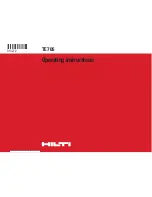
8
SECTION F: MAINTENANCE INSTRUCTIONS
F-1) ENGINE:
Maintain engine as per Instruction booklet provided with each
unit.
F-2) HYDRAULIC PUMP:
1. The hydraulic pump is capable of giving a long and
dependable service life as long as the hydraulic oil is kept
clean and the fi lters are changed at regular intervals.
2. To check the hydraulic output, energize the system with
the hydraulic pump high pressure port plugged at the tee
(if equipped with valve quick disconnect couplers, simply
disconnect the hydraulic hose) and read the pressure gauge
supplied on the unit. This reading should always be above
1800 PSI at full throttle (the reading will normally be between
2000-2500 PSI).
3. If hydraulic pump failure is suspected, be sure to check
operation of the relief valve. (See Relief Valve section). If
pump is still not functioning properly, replace pump or have it
serviced by a Prosser Pumps authorized service center.
F-3) RESERVOIR/SUCTION STRAINER:
1. It is recommended the oil be changed every 500 hours of
operation. When changing the oil the suction strainer should
be cleaned.
2. The suction strainer is mounted inside the reservoir and
may be removed for cleaning by draining the oil from the
reservoir. Strainer may then be removed and cleaned.
3. Clean the strainer with solvent or kerosene and dry with
compressed air, then re-install, making sure dirt does not
enter the reservoir. Make certain the pipe connection is tight.
F-4) SIGHT GLASS:
1. Always maintain the hydraulic oil level to the top of the
sight glass.
Be sure the operating temperature never exceeds 140
degrees F (60 degrees C).
If the temperature becomes
excessive, shut down the system and let cool.
Check
for insuffi cient oil in reservoir, kinked hydraulic hoses,
inadequate ventilation of the reservoir or oil cooler, clogged
return line fi lter, or blocked hydraulic circuit (e.g. submersible
pump impeller or tool jammed or hydraulic hose couplings
improperly connected) causing excess pressure to open the
relief valve and dump hot oil into the reservoir.
F-5) RETURN FILTER:
1. The return fi lter is located on the rear of the reservoir
alongside the high pressure outlet. The fi lter element should
be changed every 250 hours of operation.
2. Use only the exact replacement fi lter elements with 10
micron fi ltration. The element is the “spin-on” type.
3. Filter elements must be replaced when changing the oil in
the reservoir.
4. If the hydraulic oil becomes emulsifi ed or visibly dirty,
change oil and fi lter regardless of the service interval.
5. As always, keep dirt from entering the hydraulic system.
F-6) RELIEF VALVE:
1. On the PHD13G the relief valve is mounted on the rear of
the reservoir and on the PHD20G, on a bracket on top of the
fuel tank, and they are of the “remote vent” type.
2. The valve is preset at 2000-2100 PSI. To prevent damage
to any hydraulic components in the system, do not set valve
above 2100 PSI.
3. This valve is energized by the control valve and
recirculates oil back to the reservoir when it is de-energized
or subjected to pressures over the relief valve setting.
4. If a faulty relief valve is suspected, fi rst, check pressure
gauge reading at full throttle with control valve energized
and high pressure ports blocked off. On models equipped
with valved quick disconnect couplers, simply disconnect the
high pressure hose. If reading is below 1800 PSI, remove
cartridge from relief valve body and inspect for damage or
debris caught between valve seats inside cartridge.
5. If debris is found, remove it and re-install cartridge in
valve body and check pressure reading again. If any visual
damage is present (e.g. cracks, excessive wear, etc.), replace
cartridge. Valve body itself should not need replacement
unless visible damage such as cracks or damage threads
occur.
6. To set relief valve, loosen locking nut on the adjusting
screw end of cartridge, back off adjusting screw with hex
wrench several turns. Energize system the same as in testing
procedure. Slowly turn adjusting screw until pressure reading
reaches 2000 - 2100 PSI (Depending on factory settings).
Tighten locking nut and test again.
F-7) CONTROL VALVE:
1. On the PHD13G the control valve is mounted on the side
of the reservoir alongside the sight glass and on the PHD20G
the valve is mounted on the rear of the reservoir alongside
the sight glass.
2. The function of the control valve is to energize the relief
valve by means of closing off the vent port and, in turn,
creating pressure in the hydraulic system.
3. The control valve should be almost maintenance free.
4. When checking the relief valve, check the control valve and
tubing for leaks. Replace valve, tubing or tube fi tting at the
fi rst sign of leakage.
F-8) FILLER CAP AND STRAINER:
1. The fi ller cap is mounted on top of the reservoir and is
used to vent air in and out of the reservoir.
2. It is equipped with a strainer to prevent debris from
entering the reservoir when fi lling. Do not attempt to defeat
the purpose of this strainer by poking holes in it or removing
it.
Содержание PHD13G
Страница 10: ...10 FIGURE 2 Model PHD13G...
Страница 11: ...11 FIGURE 3 Model PHD13G FIGURE 4...
Страница 14: ...14 FIGURE 5 Model PHD20G FIGURE 6...
Страница 15: ...15 FIGURE 7 Model PHD20G...




































